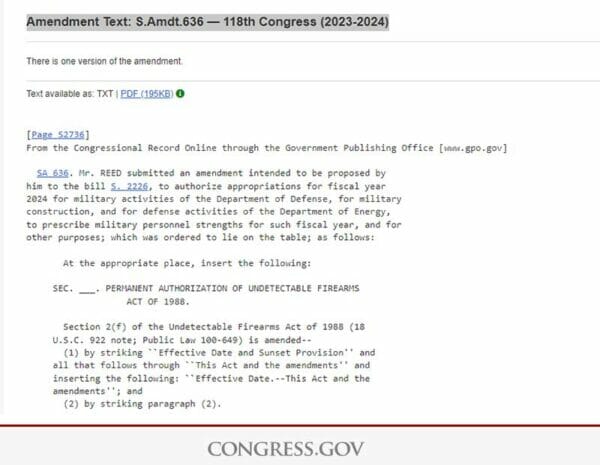
In 1988, Congress passed a bill banning “undetectable” firearms.
The Undetectable Firearms Act was a response to Glock releasing a polymer pistol. Now, the Undetectable Firearms Act is back and might be up for reauthorization, hidden in the National Defense Authorization Act (NDAA).
The Glock polymer gun design was the first polymer pistol that saw widespread adoption in the country. Anti-gun groups started to spread propaganda about Glocks not being detectable by metal detectors. Even though these accusations were false, they made it into movies such as Die Hard 2, where John McClane stated that the terrorist group was using “Glocks 7s” and could sneak by airport metal detectors.
Not only did the movie writers promote the misinformation, but so did members of Congress. The politicians were so scared that they rushed through a bill banning non-existent firearms. In truth, all guns were detectable at the time, including the dreaded Glocks. Only the frame was made of polymer. The slide, barrel, firing pin, and many other parts were and still are produced using metal. Also, the brass, lead, or copper in ammunition itself would set off metal detectors.
The bill would demand minimum amounts of metal in firearms. It was due to sunset in 2013, but Congress reauthorized it. In 2013 no gun came close to being undetectable. Now there are attempts to sneak it into the NDAA, see Amendment Text: S.Amdt.636 — 118th Congress (2023-2024),
….and this time Congress is trying for a permanent reauthorization.
Since 2013, technology has vastly increased with the rise of tech, such as 3D printing. Some of the most innovative firearms designers come from the 3D printing community. Innovative young adults at home with 3D printers, that can be purchased as low as $99, are turning out amazing designs. The common 3D printer has enabled anyone to become a firearms designer, sparking an interest in learning engineering and design skills by learning CAD software in the comfort of their own home.
Technological advancements over the past ten years have scared many anti-gun activists, including those in the Biden administration. Reauthorizing the Undetectable Firearms Act will give those that want to shut down innovation a tool to weaponize to prevent the incredible innovation of 3D-printed guns.

Senator Jack Reed (D-RI) is busy working with Republicans behind the scenes in the Senate to get the bill’s reauthorization attached to the NDAA, and it looks like it might have some bi-partisan support. Senator Chuck Schumer (D-NY) called for a vote on “Cloture” Monday onight at 5:30 PM EDT. The vote will limit the debate to 30 hours.
After the clock runs out, the Senate could vote on the amendment. Since the NDAA in the House of Representatives will conflict with the Senate version, the two sides will hold a conference to work out the differences. Both chambers will still have to pass the reconciled NDAA.
Whether this amendment to the NDAA passes or not depends on who can get their voices heard. Right now, gun owners have 10 hours to demand their Senators vote “NO” on reauthorizing the Undetectable Firearms Act. Anti-gun astroturfing campaigns are already busy lobbying Congress to reauthorize an act that can stifle innovation from the next generation of firearms designers.
About John Crump
John is a NRA instructor and a constitutional activist. John has written about firearms, interviewed people of all walks of life, and on the Constitution. John lives in Northern Virginia with his wife and sons and can be followed on Twitter at @crumpyss, or at www.crumpy.com.

